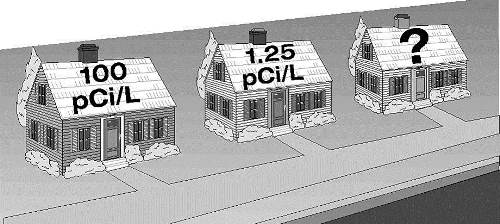
Should you be worried?
Believe it or not – this is actually debatable by some people. According to the EPA, they estimate that there are over 21,000 lung cancer deaths per year directly attributable to Radon gas. This would make Radon the second leading cause of lung cancer. On the other side of the coin, you can actually go to a “Radon Health Mine or Spa” to help eliminate or reduce issues from certain chronic illnesses. http://www.radonmine.com/why.html
In all truthfulness, both sides actually make some interesting points. This is one case where I can easily see how this falls under the Yin & Yang principle – where there is some good, there will some bad. In the end though – the question comes down to, should I test for radon in my house, and if so why?
Should I test for Radon?
In short – yes, you should have your house tested. Well, what about the health affects that the other place lists? In life, most things are good for you in moderation. Food, water, wine, enjoying a hot spa, etc…either are necessities, make one fell better and/ or can help one relax. Over doing any of those items though can possibly lead to ones death. So even if the positive effects are all legitimate, do you really think that living in that cave full time would be healthful?
How do I test for Radon?
There are numerous ways including short term & long-term tests. The first step is to pick up a test – which can easily be ordered online, picked up at a local store, or in some states, you can pick up a free test kit from the state agency in charge of Radon. (Clickable Map by the EPA for State Radon Office Locations)
The basics are pretty simple, you or the testing company place the test kit in the basement or other room* & leave it there for so many days (please refer to the directions that came with your specific kit). After that period of time, the test kit is sent in to be analyzed. Depending on the test result numbers, that will determine if you should perform a follow up test, other actions, or you can relax. (EPA guide on How to Test for Radon)
* As an FYI – In most cases, it is recommended that you do not place the test kit in the kitchen. If you have granite countertops, you may wish to place a second kit (labeled appropriately) in the kitchen if you are worried about the countertops containing high levels of radon. This was previously discussed in this article: Granite – Maintenance, Upkeep and a Geiger Counter?
When should I test?
January is National Radon Month for a reason – this is the generally the time that the greatest concentrations are found because we have closed the vents in our crawl spaces, sealed up the basements, etc… You can still perform the test anytime throughout the year, but the highest concentrations are generally during the months of November through February due to the reasons listed above. In some areas of Alabama, this may not be the norm due to Karst Geology. To find out if you live in one of these areas’s please visit http://www.aces.edu/department/family/radon/test-info.html.
How often should I test?
Most government agencies recommend that a test should be conducted every two years. They also recommend one being conducted before any major renovations are done to your property, and after the renovation has been completed. The main reason for conducting a test before hand is to see if you should at least consider putting in a passive remediation system. The main reason for testing afterwards is not to see if you can sue the builder, but to see if any changes that were made are now allowing the radon access to area’s it did not have access to before.
